Webcast: MASLD vs MetALD With Suzanne Robertazzi
Chat with MASLD AI

Hi, I am MASLD AI.
Suggested Questions :

MASLD AI 12:24 PM

In this educational session, Suzanne Robertazzi, DNP, from the Washington DC VA Medical Center, explores the evolving understanding of metabolic dysfunction-associated steatotic liver disease (MASLD) and metabolic-alcohol related liver disease (MetALD). Using a real-world case study, she walks through diagnostic clues, risk factors, and management strategies for patients with metabolic and alcohol-related components of liver disease. Viewers will learn how to interpret FibroScan results, assess alcohol intake using biomarkers such as PEth, and understand how metabolic factors like hypertension, dyslipidemia, and insulin resistance accelerate disease progression. Suzanne also reviews how to distinguish MASLD from MetALD, when to consider HCC screening, and practical steps to support patients through alcohol cessation, weight loss, and lifestyle modification. This presentation is part of the MASLD Community Network lecture series, offering APPs and hepatology professionals key insights into accurate diagnosis, patient education, and comprehensive liver health management.
Related Webcast
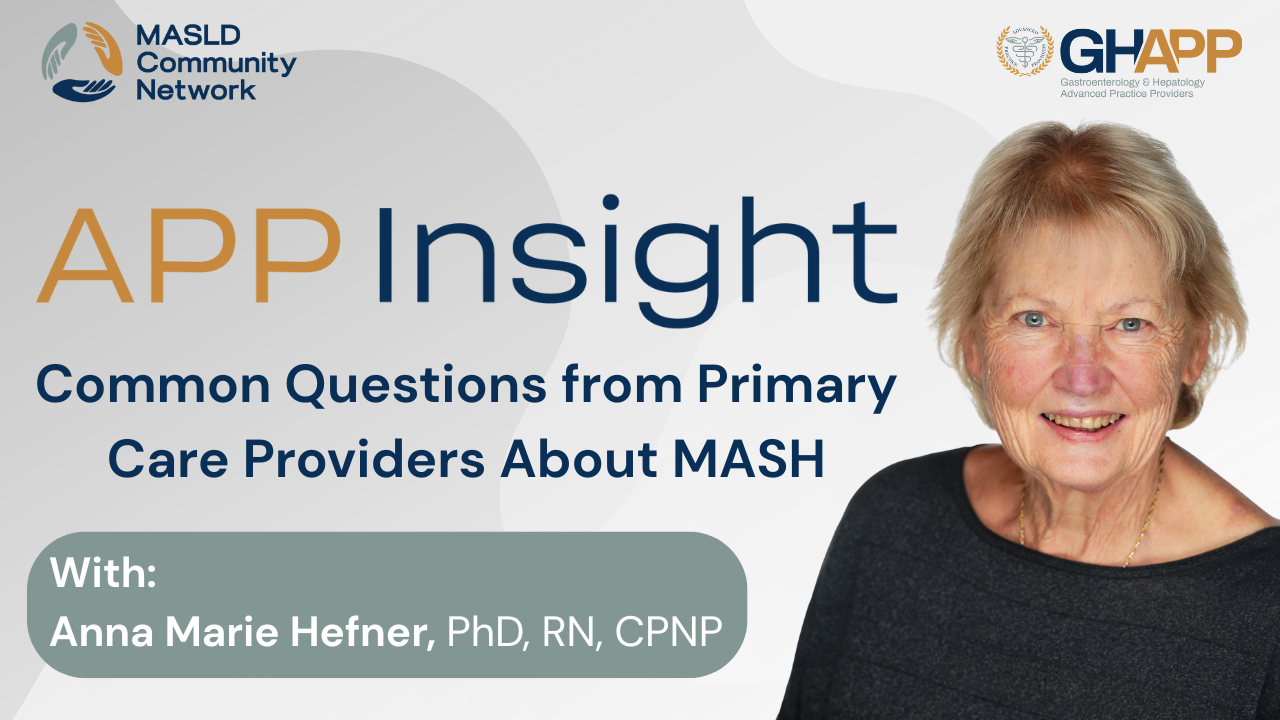
APP Insight: Common Questions From Primary Care Providers About MASH

In this educational video, Anna Marie Hefner, CPNP, a hepatology nurse practitioner at the Southern California Liver and GI Centers, shares valuable insights for primary care providers managing patients with fatty liver disease. Anna Marie explains how her community-based practice collaborates with local clinicians to streamline care for patients with MASLD (Metabolic Associated Steatotic Liver Disease) and MASH (Metabolic Associated Steatohepatitis). She outlines a clear approach for evaluating patients with elevated liver enzymes and fatty liver, including when to use non-invasive testing (NITs) such as FibroScan and how to interpret fibrosis stages (F0–F4) to guide next steps in management. Anna Marie emphasizes that patients with early-stage fibrosis (F0–F1) can often be managed in primary care with regular weight monitoring, labs, and annual imaging, while those with advanced fibrosis (F3–F4) require hepatology referral for specialized care and cirrhosis management. She also discusses how her team supports community physicians—offering FibroScan services, consultative guidance, and direct communication to ensure patients receive coordinated, evidence-based care. This session is a practical resource for APPs, hepatology teams, and primary care providers navigating fatty liver disease screening, risk stratification, and referral pathways.
Watch Now
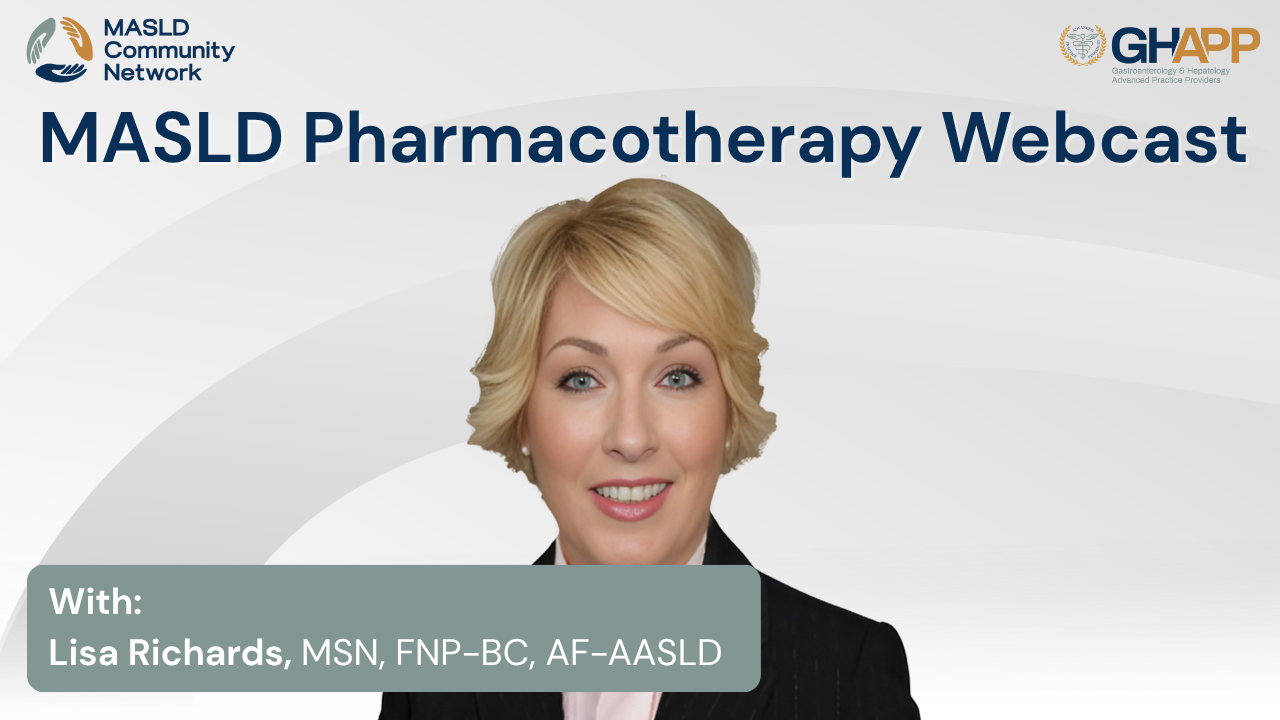
MASLD Pharmacotherapy With Lisa Richards

Join Lisa Richards, NP, from UC San Diego Health, for a comprehensive overview of MASLD Pharmacotherapy as part of the GHAPP MASLD Community Network, proudly sponsored by Madrigal Pharmaceuticals. This educational session explores the evolving treatment landscape for Metabolic Dysfunction-Associated Steatotic Liver Disease (MASLD) and MASH (Metabolic Dysfunction-Associated Steatohepatitis), including the shift from exclusive reliance on lifestyle interventions and comorbidity optimization to the introduction of targeted pharmacologic therapies. Lisa reviews the role of GLP-1 receptor agonists, such as semaglutide, and the ESSENCE trial results demonstrating significant improvements in MASH and liver fibrosis. She also outlines the clinical considerations and limitations of legacy treatments like vitamin E and pioglitazone, based on data from the PIVENS trial. The highlight of the session is a detailed exploration of resmetirom (Rezdiffra)—the first FDA-approved therapy for non-cirrhotic NASH with moderate to advanced fibrosis (F2–F3). Lisa reviews key findings from the MAESTRO-NASH trial, including improvements in fibrosis and MASH resolution, and discusses real-world implementation strategies, including non-invasive monitoring tools (FibroScan, ELF, MRI-PDFF), statin dose adjustments, and managing drug–drug interactions. This session equips hepatology and GI providers with the tools to personalize MASH care, navigate insurance and safety considerations, and deliver cutting-edge, evidence-based treatment to patients with MASLD.
Watch Now
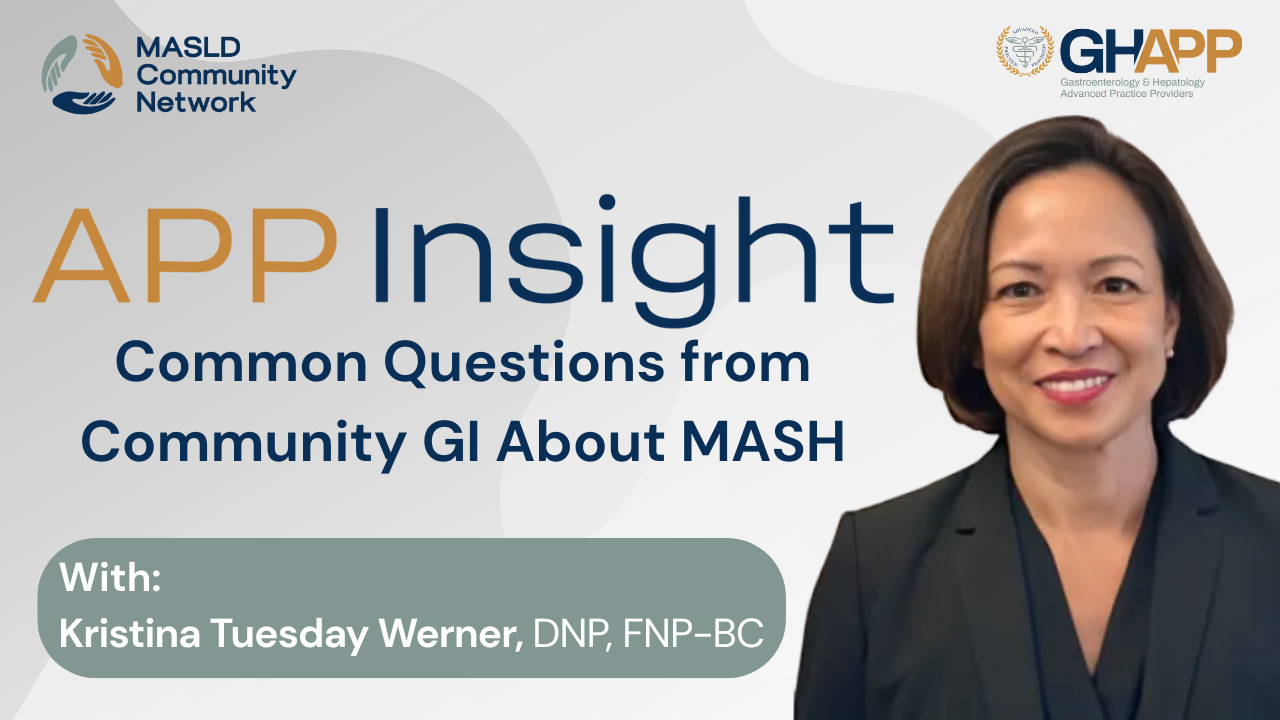
APP Insight: Common Questions From Community GI About MASH

In this educational video, Tuesday Werner, DNP, from Mayo Clinic Arizona, answers some of the most common questions she receives from Community GI in regards to fibrosis in MASLD and MASH. With over 20 years of hepatology experience, she explains what it means to be diagnosed with fatty liver disease—whether discovered incidentally on imaging or in the presence of metabolic risk factors such as obesity, hypertension, hyperlipidemia, or diabetes. Tuesday emphasizes the importance of lifestyle modification, including 5–10% weight loss, regular exercise, and optimized management of metabolic conditions to slow or reverse disease progression. She also discusses how patients with advanced fibrosis or compensated cirrhosis can stay proactive through ongoing monitoring, ultrasound or MRI surveillance every six months, and close follow-up with their hepatology team. This conversation highlights the value of community support, patient education, and multidisciplinary care in improving long-term liver health and preventing complications from MASH and MASLD.
Watch Now
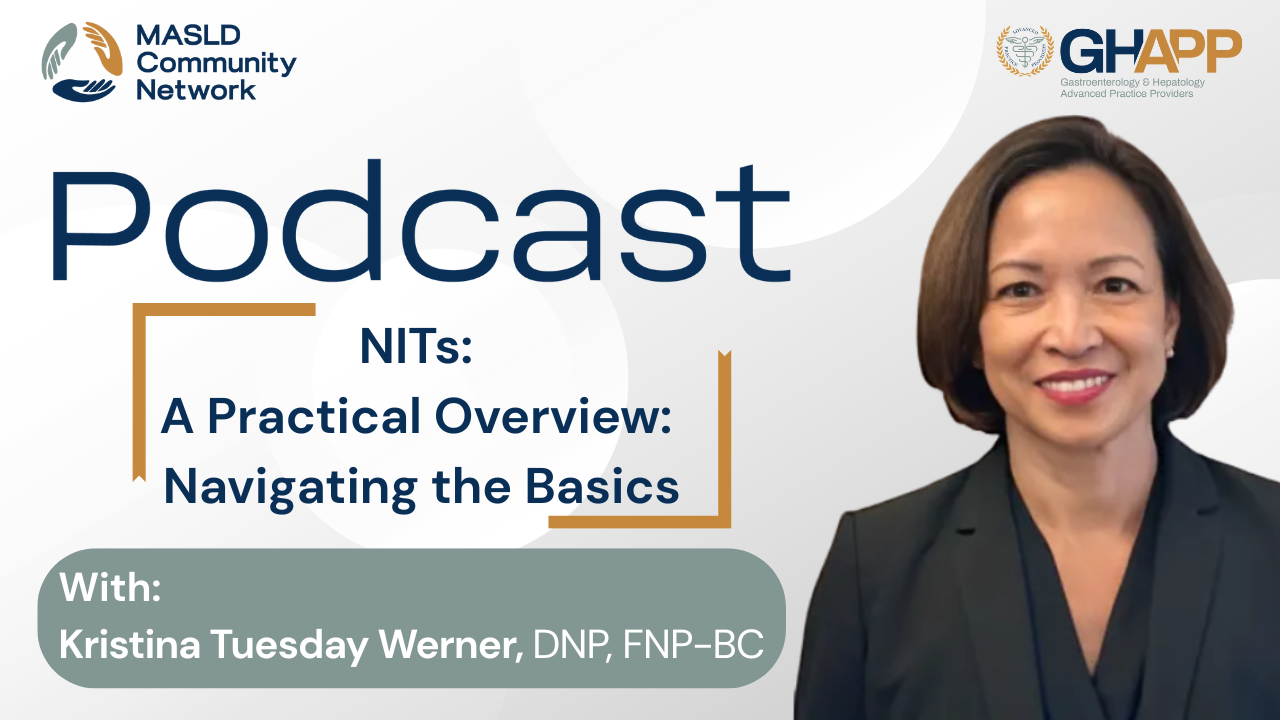
Podcast: NIT's: A Practical Overview: Navigating the Basics

In this educational session, Tuesday Werner, DNP, from Mayo Clinic Arizona, provides an in-depth overview of non-invasive testing (NITs) and their critical role in the diagnosis and management of MASLD (Metabolic Associated Steatotic Liver Disease) and MASH (Metabolic Associated Steatohepatitis). With over 20 years of experience in hepatology, she breaks down the fundamental differences between simple steatosis (MASLD) and inflammatory steatohepatitis (MASH), explaining why identifying fibrosis risk through non-invasive methods—such as FIB-4, NFS, ELF, FibroScan (VCTE), and MRE—is essential for guiding patient management, referrals, and surveillance. Tuesday discusses the strengths and limitations of serum-based vs. imaging-based NITs, emphasizing their complementary roles in evaluating fibrosis and preventing unnecessary biopsies. She also outlines how to integrate NIT results with patient history, comorbidities, and liver function tests to determine monitoring intervals and hepatology referrals. Viewers will learn key thresholds and cutoff values for interpreting FIB-4 and liver stiffness measurements, helping to stratify patients into low-, moderate-, and high-risk categories for advanced fibrosis or cirrhosis. This session underscores how NITs are transforming liver care—allowing for early detection, better patient stratification, and proactive management of MASLD and MASH through evidence-based, non-invasive approaches.
Watch Now
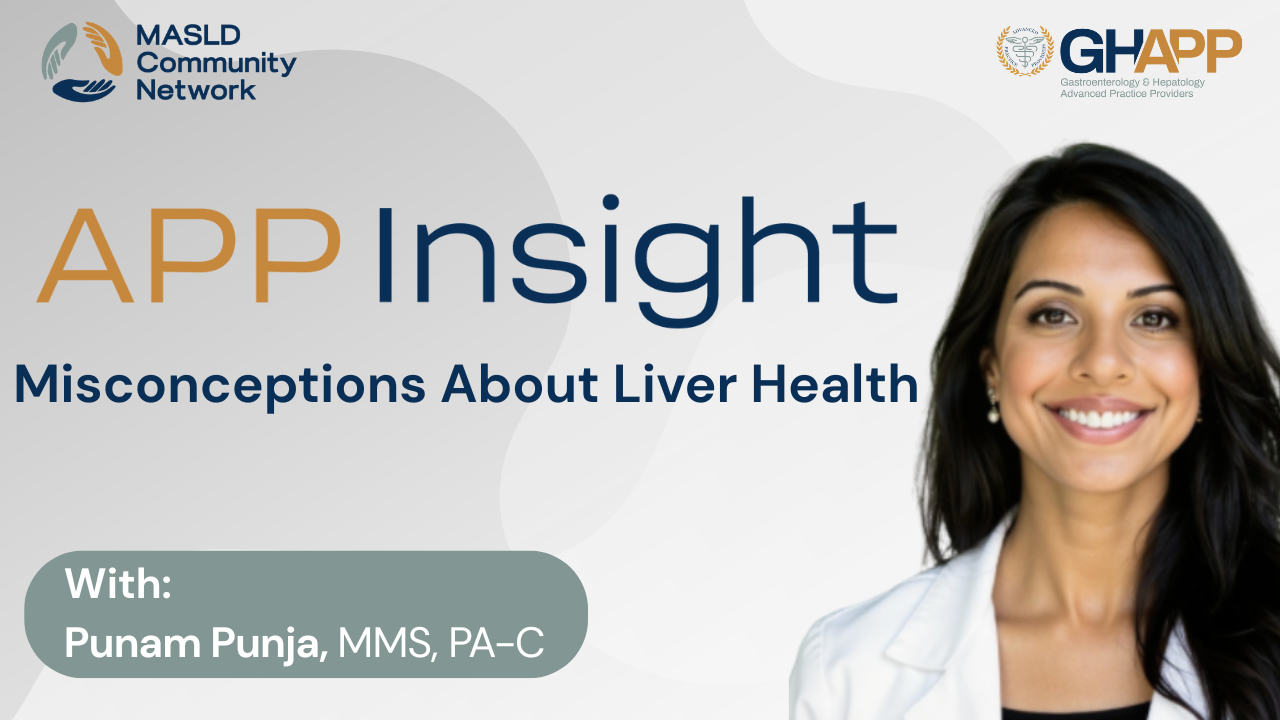
APP Insight: Misconceptions About Liver Health

In this educational video, Punam Punja, MMS, PA-C, from Emory Healthcare in Atlanta, debunks some of the most common misconceptions about liver health that often lead to confusion among patients. Drawing from over 15 years of experience in general hepatology, Punam clarifies that cirrhosis can be stable—and even partially reversible—if detected early, and that normal liver enzymes do not necessarily indicate a healthy liver. She emphasizes that acetaminophen can be used safely in moderation, even in patients with advanced fibrosis, and that symptom-free patients may still have significant liver disease. Punam also addresses myths around liver cleanses, viral versus autoimmune hepatitis, and the misconception that only alcohol or viruses cause fibrosis, highlighting MASLD (Metabolic Dysfunction–Associated Steatotic Liver Disease) as one of the most prevalent modern causes. She encourages providers and patients alike to stay informed and proactive in managing liver health.
Watch Now
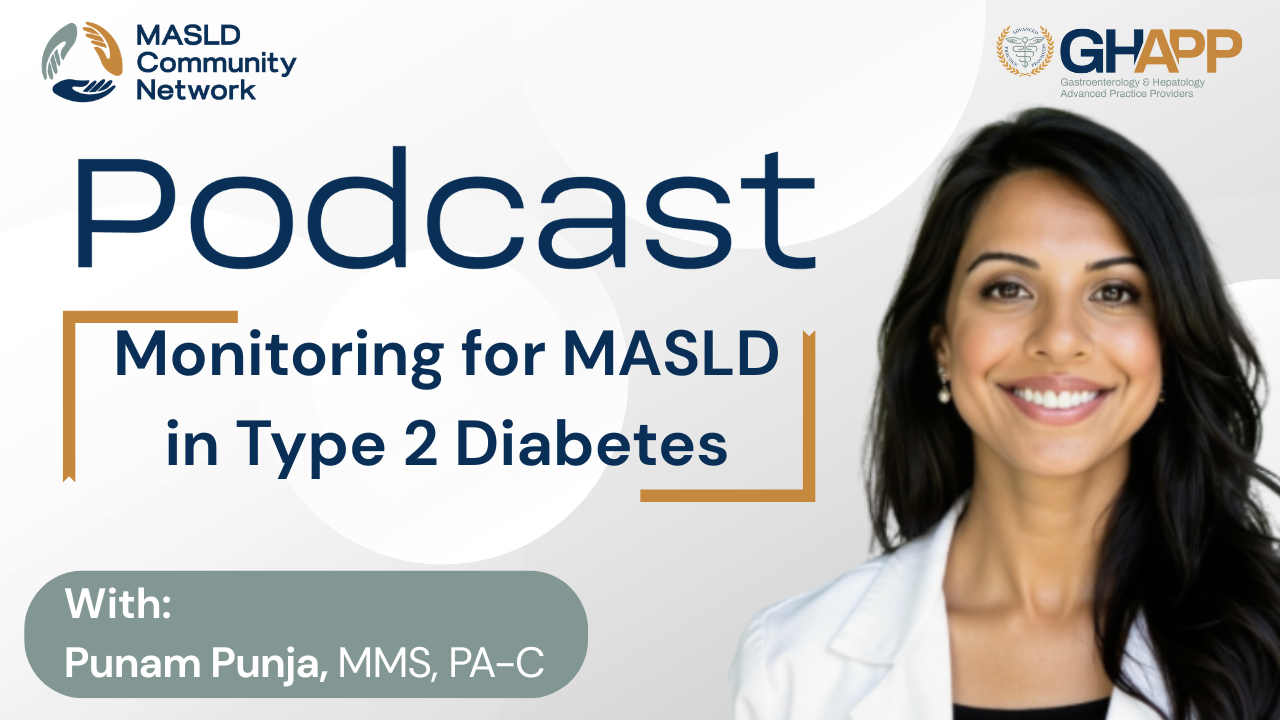
Podcast: Monitoring for MASLD in Type 2 Diabetes

In this educational session, Punam Punja, MMS, PA-C, from Emory Healthcare in Atlanta, discusses the crucial connection between type 2 diabetes and MASLD (Metabolic Dysfunction–Associated Steatotic Liver Disease). With over 15 years of hepatology experience, Punam outlines a practical, evidence-based approach for screening and monitoring patients with type 2 diabetes who are at risk for MASH (Metabolic Associated Steatohepatitis). She explains how the American Diabetes Association (ADA) now recommends routine fibrosis screening using the FIB-4 index, a simple, non-invasive calculation that helps identify patients at risk for advanced fibrosis — the strongest predictor of liver-related outcomes. Punam breaks down risk thresholds, screening intervals, and the role of secondary assessments such as transient elastography or ELF testing. She also emphasizes the importance of patient education, noting that unlike diabetic complications such as retinopathy, MASH is often silent but reversible with lifestyle modification. As October marks National Liver Awareness Month, Punam encourages APPs to make liver screening a standard part of diabetes care.
Watch Now
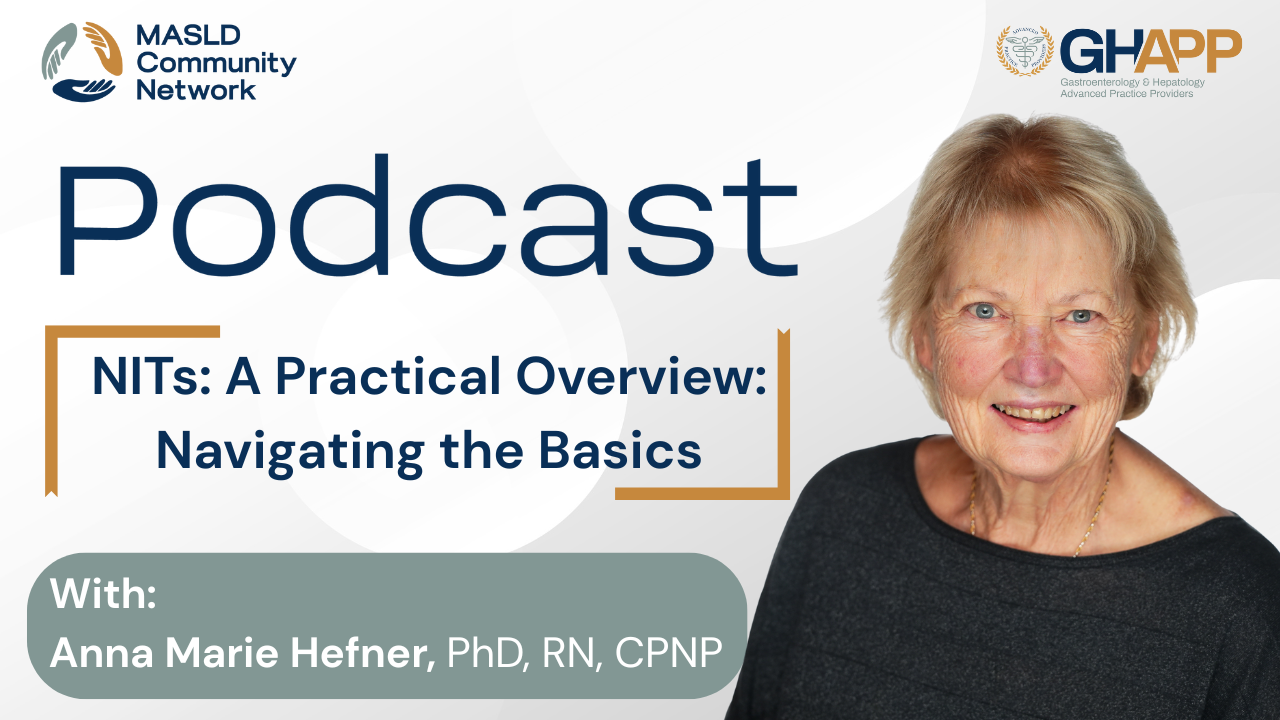
Podcast: NITs: A Practical Overview: Navigating the Basics

In this informative session, Anna Marie Hefner, CPNP, a hepatology nurse practitioner at the Southern California Liver and GI Center, shares her 15+ years of experience managing patients with MASLD (Metabolic Associated Steatotic Liver Disease) and MASH (Metabolic Associated Steatohepatitis). She explains how her clinic has created a collaborative, patient-centered approach—hosting dedicated fatty liver clinics that foster education, peer support, and lifestyle discussion among patients. Anna Marie walks viewers through how to distinguish between simple steatosis and MASH, emphasizing that proper diagnosis drives appropriate management—from lifestyle counseling and diet modification for early stages to medication and specialist referral for advanced fibrosis or cirrhosis. She offers a detailed overview of non-invasive tests (NITs) such as FIB-4, ELF, FibroScan, and MRI elastography, outlining how each test is performed, how to interpret key cutoff values, and when to refer patients to hepatology. She also highlights the importance of evaluating comorbidities, including cardiovascular and metabolic risk factors, medication history, and family health background, as part of comprehensive liver assessment. Finally, she encourages providers to follow AASLD and EASL guidelines, utilize collaborative care across specialties, and engage with professional APP organizations like GHAPP to stay current on evolving best practices in fatty liver disease management.
Watch Now
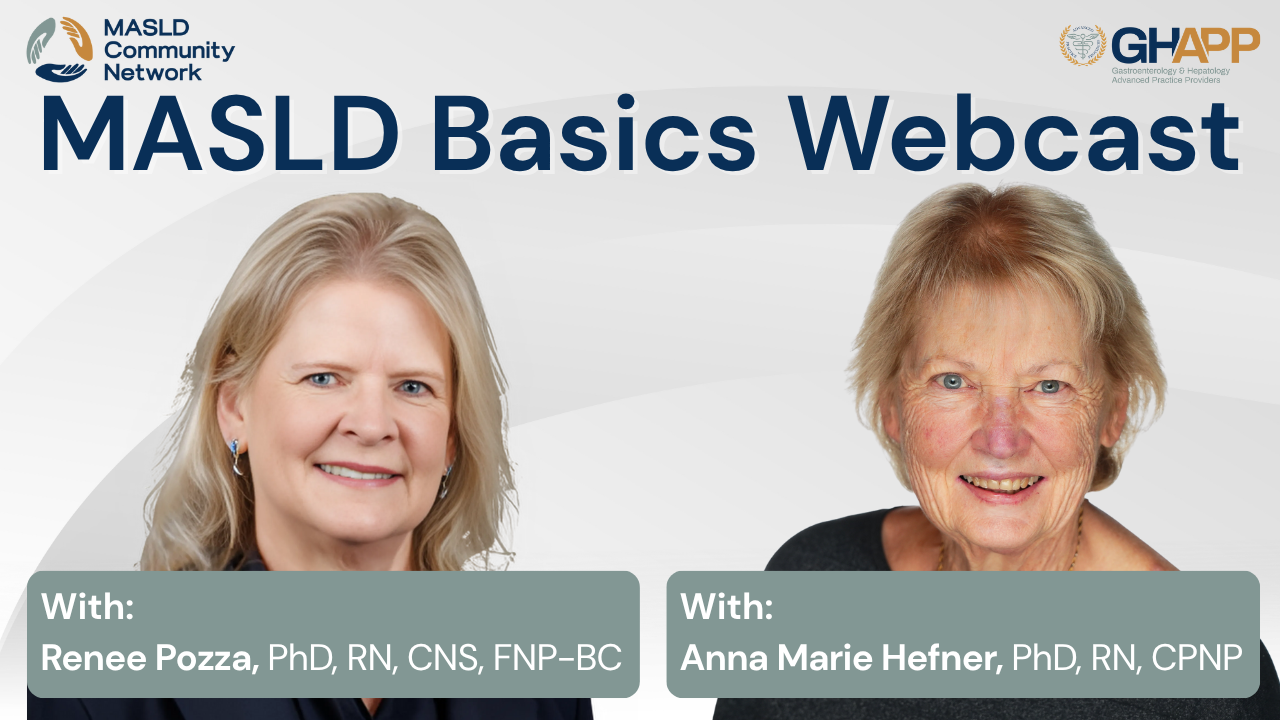
Webcast: MASLD Basics With Anna Marie Hefner & Renee Pozza

In this MASLD Community Network session, Anna Hefner, PhD, RN, CPNP, and Renee Pozza, PhD, RN, CNS, FNP-BC, of Southern California GI & Liver Centers break down the new nomenclature for steatotic liver disease (SLD) and what it means for clinical practice. They clarify how to distinguish MASLD from MASH, introduce the overlap category MetALD (metabolic-associated alcohol-related liver disease), and review differential causes of steatosis—from medications and viral hepatitis to genetic and cryptogenic etiologies. The faculty walk through practical primary-care screening with FIB-4, when to escalate with noninvasive tests (FibroScan® CAP/kPa, ELF), and the roles of ultrasound and MRI/MRE—plus when a liver biopsy is still warranted. You’ll learn staging cues (F0–F4), progression risk, who needs closer follow-up, and how to counsel patients on cardiometabolic risk reduction (weight loss, activity, triglyceride/HDL management, blood pressure, glucose). The talk also highlights pediatric considerations, terminology changes to reduce stigma, and tips for consistent waist-circumference measurement and alcohol-intake assessment—equipping PCPs, GI, and hepatology teams to identify fibrosis early and improve outcomes.
Watch Now
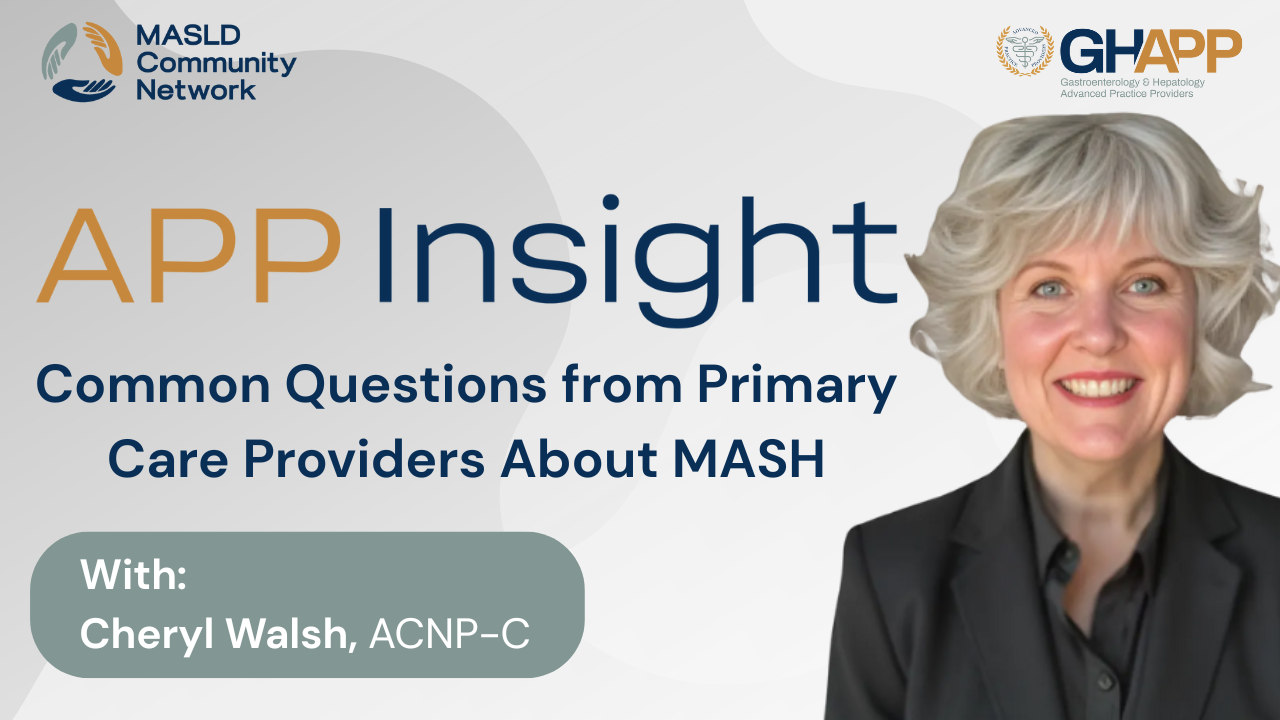
APP Insight: Common Questions From Primary Care Providers About MASH

In this educational video, Cheryl Walsh, ACNP-C, from GI Alliance in Northwest Arkansas, shares practical guidance for primary care providers on how to effectively support patients with elevated liver enzymes. With nearly 15 years of experience in gastroenterology and hepatology, Cheryl explains how simple first steps—such as ordering imaging studies and incorporating the FIB-4 index into lab work—can provide valuable insight into whether a patient may have MASLD (Metabolic Dysfunction–Associated Steatotic Liver Disease) or even early fibrosis. She highlights how these preliminary evaluations streamline care, allowing hepatology specialists to move forward quickly with advanced imaging or elastography when needed. Cheryl underscores the importance of collaboration between primary care and GI teams to ensure early detection and better patient outcomes in metabolic liver disease.
Watch Now
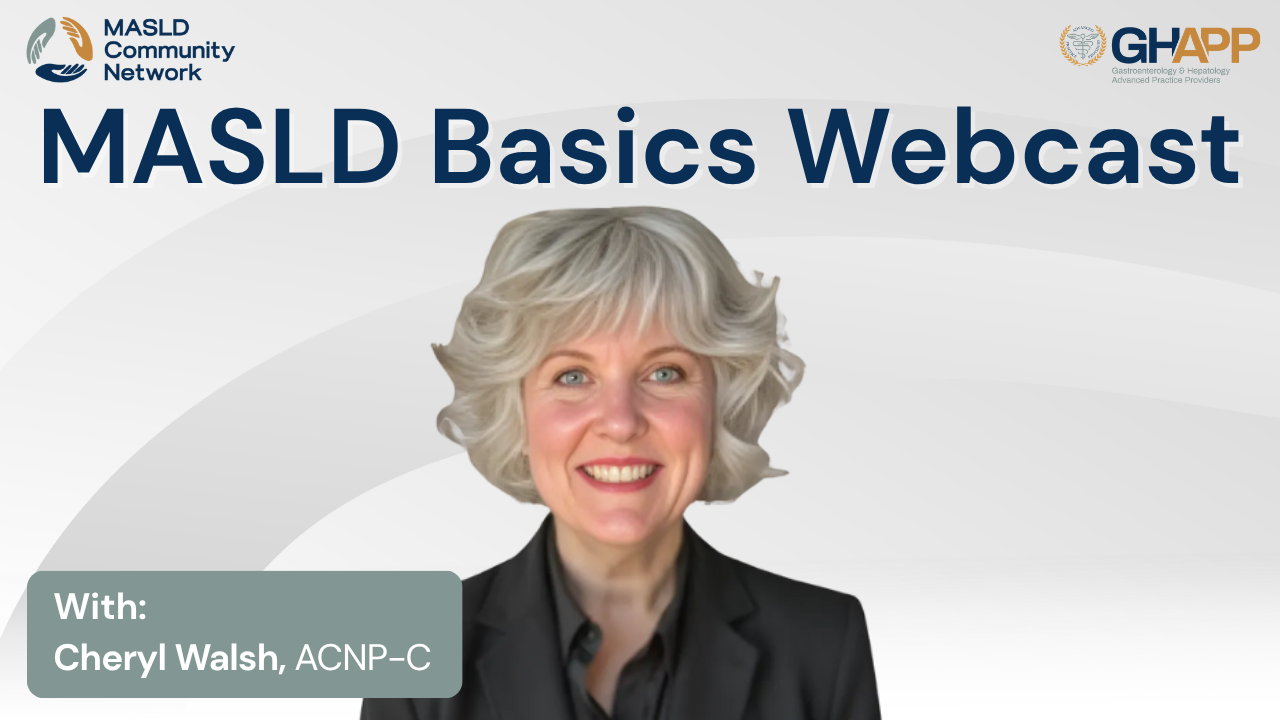
Webcast: MASLD Basics With Cheryl Walsh

In this MASLD Basics session of the MASLD & MASH Community Network, Cheryl Walsh, ACNP-C explains the new steatotic liver disease (SLD) nomenclature and how to apply it in practice. She clarifies definitions of MASLD, distinguishes MASH, and introduces overlap with MetALD by reviewing practical alcohol-intake thresholds. Cheryl outlines a stepwise primary-care pathway: start with FIB-4 to risk-stratify fibrosis, then use noninvasive tests such as elastography or the ELF blood test, with ultrasound/MRI as needed—and consider liver biopsy only for discordant or indeterminate results. You’ll learn when to reassess (F0–F1 every 2–3 years; F2–F3 annually with consideration of pharmacotherapy), when to refer to hepatology, and why fibrosis—not steatosis alone—drives prognosis. The talk also highlights global epidemiology, the stigma-reducing benefits of the new terminology, and patient counseling on lifestyle change (Mediterranean-style nutrition, activity, weight management) to alter disease trajectory.
Watch Now





 October 2025
October 2025 